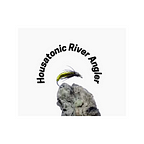Fall Fly Fishing On The Housatonic River
Along with colder temperatures and shorter days Fall brings us the best fishing of the year on the Housatonic River. Many things begin to change during the Fall and not just leaf color. The water and air temperatures are dropping making insect activity transition to daytime. Spawning season is beginning for brown trout and brook trout giving anglers an extra treat with their spawning colors. During this changing time trout really want to pack on some extra weight before Winter arrives. As Fall begins to set in along the river it’s also your best chance of the season to hook into some trophy trout. Streamer fishing on the Housatonic River at this time is very productive and is the best around. Nothing like getting a streamer hit by large brown trout and big rainbows. There are many great nymphing and dry fly opportunities to be had as well during some great Fall time hatches.
Although technically not a hatch swarms of flying ants can produce some of the finest dry fly action of the year. Usually around September they start to appear and the fish will not be eating much else when flying ants are on the water. The swarms of flying ants consist of winged males and new queens from local ant colonies. As we know every ant has a job to do the winged males are trying to mate with the new queens that are from different colonies. The new queen is looking to establish a new colony after she has mated. These swarms generally occur a couple of days after a good rain storm and can be quite heavy sometimes with many falling onto the water. I carry a few different color flying ant patterns in cinnamon, black and dark purple in sizes #16-#20.
Late season Isonychia or Iso’s is a phenomenal hatch that happens during daylight and provides great dry fly fishing and nymphing. If your a dry fly enthusiast you can easily coax a hungry trout into eating an Iso dry fly. The tried an true pattern the Adams in a #10-#12 is always a fine choice to imitate an Iso dun. Iso nymphs are quite large #10-#12 swimmers and I’ve found it’s necessary to have an exact imitation. Some have a beautiful white stripe running down their backs. So you can have a lot of fun at the vice tying imitations of these nymphs, Mercer’s Poxyback Isonychia Nymph in #10-#12 and Zug Bug in #10-#12 are effective. Iso nymphs are known to swim and crawl into the shallows before they emerge often shedding their shucks on top of stones. So as always fish the water before you step into it.
As mentioned above Fall is spawning season for brown trout and brook trout and an egg fly can be very effective at times. Top egg colors on the Housatonic have been a peachy orange, lighter shades of pink and chartreuse. I tie eggs in many different sizes in the colors listed above and I like to have a blood dot on them. Dead drift them along the bottom in your double nymph setup preferably as your dropper fly. Egg flies usually aren’t weighted so it needs to be escorted down by a heavier point fly or split shot.
Blue Winged Olive activity really starts to increase during the Fall months. Nymphing small BWO nymphs can be extremely productive, especially on cloudy days when they’re hatching heavily. Favorite nymph patterns are Micro Mayfly#18-#22, Pheasant Tail #18-#22 and Olive Serendipity #18-#22. BWO dry fly fishing is also a ton of fun when there are risers sipping these tiny bugs off the surface. A high visibility parachute pattern #18-#22 is a great choice it can be seen easily by the angler and it sits nicely in the surface film. A two dry fly setup is another great option. Fish a larger dry fly then tie an olive pattern 10"-12" off the hook bend of the larger fly.
Caddis activity also increases especially subsurface and it’s always a good idea to try larva and pupa imitations. For simplicity I’ll just name a few Cinnamon(Spotted Caddis), Little Blacks and late season Green Caddis which are sporadic. All are easy to imitate with the patterns listed below with simple color variations(match the hatch). Keep an eye out for smaller Caddis on the surface trout can really dial in on the pupa below, often neglecting the adults above. A good indicator that this is happening is when you see flashes from fish as they are slashing at pupa rising up through the water column. And it may look like a surface rise but most of the feeding is happening down below. Nymphing will be effective and allow your flies to swing up at the end of the drift. That swing brings your nymphs up through the water column and can encourage a strike on their way to the surface. A couple of favorite pupa patterns are Graphic Caddis Olive/Brown #14-#18, Serendipity Brown/Olive #14-#20. I’m not picky when it comes to larva(cased) or (uncased) #12-#16. A few proven dry flies are Elk Hair Caddis in tan/olive #12-#20, Henryville Special #12-#20 and X-Caddis in tan/olive#12-#20.
Just to summarize Fall on the Housatonic River it is simply an amazing experience to be on the water. Great fly fishing opportunities no matter your favorite method dry flies, nymphs, wet flies or streamers. Gorgeous views of the river with a back drop of rollings hills with colorful changing leaves.
Tight Lines!!
-HousatonicRiverAngler
